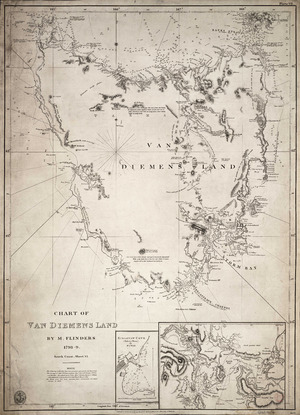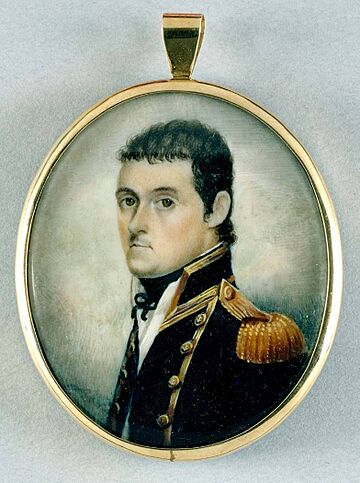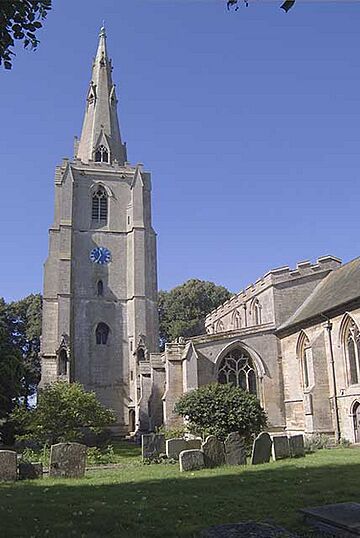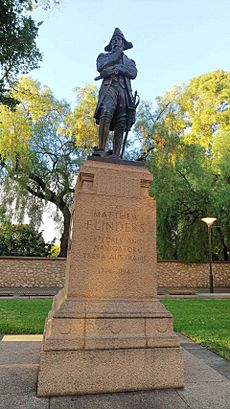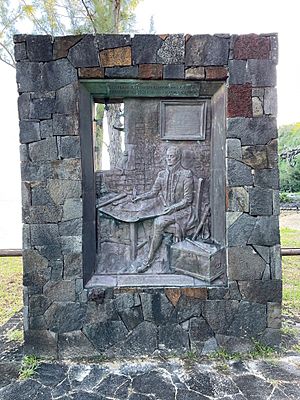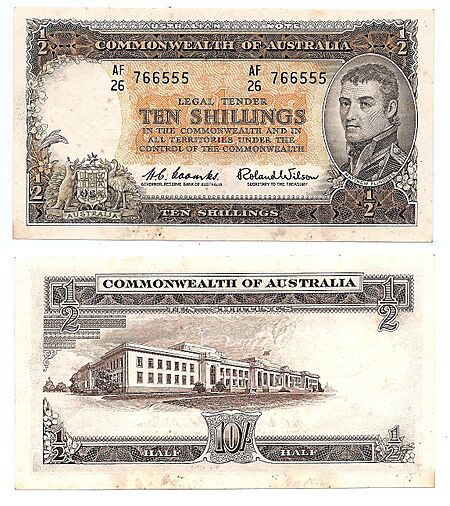Matthew Flinders facts for kids
Quick facts for kids
Matthew Flinders
|
|
|---|---|
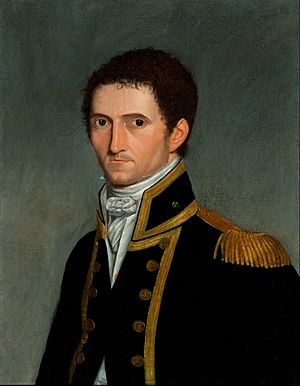
Portrait by Antoine Toussaint de Chazal, painted in Mauritius in 1806–07
|
|
| Born | 16 March 1774 Donington, Lincolnshire, England |
| Died | 19 July 1814 (aged 40) London, England |
| Buried |
St James's burial ground, Camden, London (until 2019);
Church of St Mary and the Holy Rood, Donington, Lincolnshire (from 2024) |
| Allegiance | Great Britain |
| Service/ |
Royal Navy |
| Years of service | 1789 - 1803 |
| Rank | Captain |
| Spouse(s) |
Ann Chappelle
(m. 1801) |
| Children | 1 |
Captain Matthew Flinders (born 16 March 1774 – died 19 July 1814) was a brave British Royal Navy officer, a skilled navigator, and a talented mapmaker. He led the first journey to sail all the way around the coast of mainland Australia, which was then known as New Holland. Flinders is also famous for being the first person to suggest using the name Australia for the entire continent, including Van Diemen's Land (now Tasmania). He thought this name sounded "more agreeable to the ear."
Flinders took part in several important voyages of discovery between 1791 and 1803. His most famous trips include sailing around Australia and an earlier expedition with George Bass. On that trip, they proved that Van Diemen's Land was a separate island. In 1803, while returning to Britain, Flinders was held by the French on the Isle de France (now Mauritius). Even though Britain and France were at war, Flinders believed his scientific work would protect him. However, he remained held for over six years. During this time, he wrote down details of his journeys for a book and explained why he thought Australia was the best name for the new continent. This idea was later supported by Governor Macquarie.
Flinders' health suffered during his time away. He returned to Britain in 1810 but passed away in 1814. He did not live to see his highly praised book and maps, A Voyage to Terra Australis, become a success. For many years, the exact location of his grave was unknown. But in January 2019, archaeologists working on a new rail project near London's Euston railway station announced they had found his remains. On 13 July 2024, Matthew Flinders was reburied in Donington, Lincolnshire, the village where he was born.
Contents
Matthew Flinders was born in Donington, Lincolnshire, England. His father, also named Matthew, was a surgeon. Matthew went to school in Donington and later in Horbling.
He once said that reading Robinson Crusoe made him want to go to sea, even though his family didn't want him to. In 1789, at just fifteen years old, he joined the Royal Navy. With help from Captain Thomas Pasley, Flinders started as a servant on a ship called HMS Alert. He quickly moved up to an able-seaman on HMS Scipio and then became a midshipman on HMS Bellerophon in July 1790.
First Big Adventure with Captain Bligh
In May 1791, Flinders joined Captain William Bligh's expedition on HMS Providence. Their mission was to transport breadfruit plants from Tahiti to Jamaica. This was Bligh's second "Breadfruit Voyage." The ship sailed around the Cape of Good Hope and reached Adventure Bay in February 1792. This bay is on the eastern coast of Bruny Island, near what is now Tasmania.
The crew spent over a week there, getting water and wood. They also met local Aboriginal people. This was Flinders' first time seeing the land that is now part of Australia. After collecting breadfruit in Tahiti, they sailed back west. They went through the Torres Strait, north of Australia. There, they had a conflict with armed local men in canoes, which resulted in some people getting hurt. The expedition arrived in Jamaica in February 1793. Flinders returned to England in August 1793 after more than two years at sea.
In September 1793, Flinders returned to HMS Bellerophon under Captain Pasley. In 1794, he was part of a big naval battle called the Glorious First of June. This was a major fight between Great Britain and France during the French Revolutionary Wars. Flinders kept a detailed journal of the battle. He wrote about how Captain Pasley was seriously injured. Both Flinders and Pasley survived. After this intense experience, Flinders decided he preferred exploring new lands over fighting in wars.
Exploring New South Wales
Flinders' love for adventure led him to join HMS Reliance in 1795 as a midshipman. This ship was sailing to New South Wales, carrying the new governor, Captain John Hunter. On this journey, Flinders became good friends with the ship's surgeon, George Bass. Bass was three years older and came from a town not far from Flinders' birthplace.
Small Boat Expeditions: Tom Thumb Voyages
Reliance arrived in Port Jackson (Sydney Harbour) in September 1795. Soon after, Bass and Flinders planned an expedition in a small open boat called Tom Thumb. With a boy named William Martin, they sailed to Botany Bay and up the Georges River. In March 1796, the two explorers, again with William Martin, took a larger boat, Tom Thumb II. They sailed south from Port Jackson. They had to stop at Red Point (Port Kembla) and received help from two Aboriginal men. These men guided their boat to Lake Illawarra, where they could get fresh water. On their way back to Sydney, they also explored parts of Port Hacking (Deeban).
Proving Tasmania is an Island
In 1798, Flinders, who was now a lieutenant, was given command of the sloop Norfolk. His orders were to explore beyond Furneaux's Islands and find out if there was a strait (a narrow waterway) between Van Diemen's Land and the mainland. Flinders and Bass had already explored parts of the area separately, but they hadn't found a clear answer.
Flinders, with Bass and his crew, sailed Norfolk along the unknown northern and western coasts of Van Diemen's Land. They rounded Cape Pillar and returned to Furneaux's Islands. By doing this, Flinders had sailed all the way around Van Diemen's Land. He confirmed that it was indeed an island, separated from the mainland by a strait. This passage was named Bass Strait after his friend. Later, the largest island in the strait was named Flinders Island in his honor. During this journey, Flinders and Bass also met Aboriginal Tasmanians while exploring the River Derwent.
Exploring Queensland's Coast
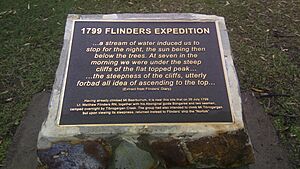
In 1799, Flinders received permission to explore the coast north of Port Jackson. Again, the sloop Norfolk was his ship. George Bass had returned to Britain, so Flinders brought his brother Samuel Flinders and an Aboriginal man named Bungaree on this voyage. They left on 8 July 1799 and arrived in Moreton Bay six days later.
Flinders landed at Woody Point and named a nearby spot Redcliffe because of its red cliffs. He also landed on Coochiemudlo Island on 19 July while looking for a river. In the northern part of Moreton Bay, Flinders explored a narrow waterway he called the Pumice Stone River. This waterway actually separates Bribie Island from the mainland and is now known as the Pumicestone Passage.
Most meetings with the Aboriginal people of Moreton Bay were friendly. However, on 15 July, at the southern tip of Bribie Island, a conflict occurred, and a local man was wounded. Flinders named this spot Point Skirmish. While anchored, Flinders, Bungaree, and two other crew members walked several kilometers inland and climbed Mount Beerburrum. They had to turn back after reaching the steep cliffs of Mount Tibrogargan around 26 July. After leaving Moreton Bay, Flinders continued exploring north to Hervey Bay before returning to Sydney on 20 August 1799.
Leading the Investigator Expedition
In March 1800, Flinders returned to Britain. His work had impressed many scientists, especially Sir Joseph Banks. Banks used his influence to convince the Admiralty (the British Navy's governing body) that an expedition to map the coast of New Holland was very important.
As a result, in January 1801, Flinders was given command of HMS Investigator, a 334-ton sloop. He was promoted to commander the next month. Investigator set sail for New Holland on 18 July 1801. The expedition included scientists like the botanist Robert Brown, artist Ferdinand Bauer, and Flinders' cousin, the future explorer John Franklin, who served as a midshipman.
Mapping the Australian Coastline
Surveying the Southern Coast
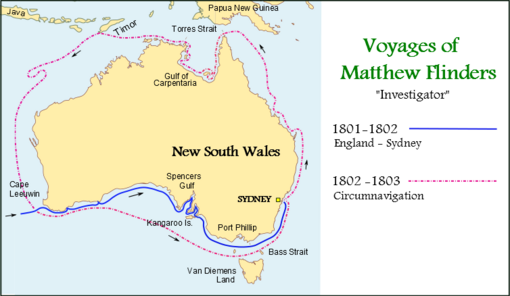
Aboard Investigator, Flinders reached and named Cape Leeuwin on 6 December 1801. He then began mapping the southern coast of the Australian mainland. The expedition stopped in King George Sound for a month to explore. Local Aboriginal people initially wanted Flinders' group to leave, but relations improved.
Near Port Lincoln, which Flinders named after his home county of Lincolnshire, eight of his crew were lost. Their small boat capsized while returning to the ship. Flinders named nearby Memory Cove in their honor. On 21 March 1802, the expedition found a large island with many kangaroos. Flinders and his crew went ashore and found the animals so tame they could walk right up to them. They hunted 31 kangaroos for food. Flinders named this place Kangaroo Island to thank them for the much-needed meat.
On 8 April 1802, Flinders met a French ship, Géographe, commanded by explorer Nicolas Baudin. Baudin was on a similar mission for his government. Despite their countries being at war, Flinders and Baudin, both scientists, shared details of their discoveries. Flinders named the bay where they met Encounter Bay.
Continuing along the coast, Flinders explored Port Phillip (where the city of Melbourne is now). He climbed Arthur's Seat, the highest point near the bay, and noted the land looked "pleasing and fertile." After climbing the You Yangs on 1 May, he left a scroll with the ship's name in a pile of stones. With supplies running low, Flinders sailed to Sydney, arriving on 9 May 1802.
Sailing Around Australia
Flinders spent about three months in Sydney, getting new supplies and more crew for the next part of his journey. Bungaree, the Aboriginal man who had joined him before, came along again, as did another local Aboriginal man named Nanbaree. Captain John Murray and his ship Lady Nelson were arranged to accompany Investigator as a supply ship.
Flinders set sail again on 22 July 1802, heading north to map the coast of what would become Queensland. They stopped at Sandy Cape, where Bungaree helped them share a meal of porpoise blubber with a group of Batjala people. In early August, Flinders sailed into Port Curtis. Here, local people threw stones at them, and Flinders had to fire muskets over their heads to make them leave.
As they went further north, navigating became very difficult because of the Great Barrier Reef. Flinders called these "Barrier Reefs" in his book because they blocked safe passage. Lady Nelson was found to be too old and unsafe to continue, so Captain Murray sailed her back to Sydney with his crew and Nanbaree. Flinders then guided Investigator out of the reefs near the Whitsunday Islands and sailed north to the Torres Strait. On 29 October, they reached Murray Island, where they traded iron for shell necklaces with the local people.
The expedition entered the Gulf of Carpentaria on 4 November and mapped the coast to Arnhem Land. At Blue Mud Bay, the crew had a conflict with local Aboriginal men while collecting wood. Some people were hurt. At nearby Caledon Bay, Flinders briefly held a 14-year-old boy named Woga to try and get back a stolen axe. On 17 February 1803, near Cape Wilberforce, they met a Makassan fishing fleet led by a man named Pobasso, who gave Flinders information about the area.
During this part of the voyage, much of Investigator was found to be rotting. Flinders decided to finish sailing around the continent without doing any more detailed coastal mapping. He sailed to Sydney by way of Timor and the western and southern coasts of Australia. Along the way, Flinders threw two heavy iron anchors overboard. These anchors were found by divers in 1973 at Middle Island, Recherche Archipelago, Western Australia. The anchors are now on display in museums in Port Adelaide and Canberra.
Investigator arrived back in Sydney on 9 June 1803. The ship was in such bad condition that it was declared unsafe.
Detained in Mauritius
Flinders could not find another ship for his explorations. So, he sailed for Britain as a passenger on HMS Porpoise. However, the ship was wrecked on Wreck Reefs, part of the Great Barrier Reef, about 700 miles (1,100 km) north of Sydney. Flinders bravely sailed the ship's small cutter back to Sydney across the open sea. He then arranged for the rescue of the stranded crew.
Flinders then took command of a small 29-ton schooner called HMS Cumberland to return to England. But the ship was in poor condition, forcing him to stop for repairs at the French-controlled Isle de France (now Mauritius) on 17 December 1803. This was just three months after Baudin had passed away there.
War with France had started again the previous May. Flinders hoped his French passport, issued for Investigator, and the scientific nature of his mission would allow him to continue his journey safely.
However, the French governor, Charles Mathieu Isidore Decaen, detained Flinders. The relationship between them became difficult. Decaen was suspicious because Cumberland carried no scientists, and a search of Flinders' ship found papers (including messages from the New South Wales Governor Philip Gidley King) that were not allowed under his scientific passport. One of King's messages even asked for more British troops in case Decaen attacked Port Jackson. Among the papers taken were three logbooks from HMS Investigator. Only two were returned to Flinders; the third is now in The National Archives (United Kingdom).
Decaen sent the matter to the French government, but the war caused delays. Eventually, on 11 March 1806, Napoleon approved Flinders' release. But Decaen still refused, believing Flinders knew too much about the island's defenses. In June 1809, the Royal Navy began blocking the island, and in June 1810, Flinders was finally released. He traveled via the Cape of Good Hope and was promoted to post-captain before continuing to England.
Flinders was confined for the first few months of his captivity. Later, he was allowed more freedom to move around the island and access his papers. In November 1804, he sent the first map of the landmass he had charted back to England. This was the only map Flinders made where he used the name Australia or Terra Australis in the title, instead of New Holland. This was the first known time he used the word Australia. He used New Holland only for the western part of the continent on this map. Because of his long detention, the first published map of the Australian continent was the Freycinet Map of 1811, from the Baudin expedition, issued in 1811.
Flinders finally returned to England in October 1810. He was in poor health but immediately started working on his book, A Voyage to Terra Australis, and his atlas of maps. The book was published in London in July 1814. It included details of his voyages, the shipwreck of the Porpoise, and his detention in Mauritius. Original copies of the Atlas to Flinders' Voyage to Terra Australis are held at the Mitchell Library in Sydney. Flinders' map of Terra Australis or Australia was first published in January 1814.
Death and Reburial
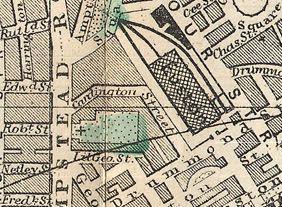
Flinders passed away at age 40 on 19 July 1814, from kidney disease, at his London home. This was the day after his book and atlas were published. Flinders was unconscious by then, but his wife arranged the volumes on his bed so he could touch them. On 23 July, he was buried in the burial ground of St James's Church, Piccadilly, near Hampstead Road, Camden, London. By 1852, the exact location of his grave had been forgotten due to changes in the burial ground.
In 1878, the cemetery became St James's Gardens. Part of these gardens was later built over when Euston station expanded, and it was thought Flinders' grave might be under a station platform. The Gardens were closed in 2017 for work on the High Speed 2 (HS2) rail project, which needed Euston station to expand.
His grave was found in January 2019 by archaeologists. His coffin was identified by its well-preserved lead coffin plate. A documentary about the discovery and exhumation was shown on British television in September 2020. It was decided to rebury his remains after they were studied by experts.
After his grave was found, the church in Donington, Lincolnshire, Flinders' birthplace, saw many visitors. Groups and Flinders' family campaigned to have his remains reburied at the Church of St Mary and the Holy Rood in Donington. On 17 October 2019, HS2 Ltd announced that Flinders' remains could be reinterred there. Permission was given for reburial in the north aisle. His remains were reburied on 13 July 2024. The coffin used for his reburial was a replica of his original one, made by one of the archaeologists. The church also displayed a recently found portrait, believed to be of Flinders in his later years.
Family Life
On 17 April 1801, Flinders married his longtime friend Ann Chappelle (1772–1852). He had hoped to take her with him to Port Jackson. However, the Admiralty had strict rules against wives traveling with captains. Flinders tried to ignore these rules and brought Ann on board. But the Admiralty found out and told him off, ordering him to remove her from the ship. This is known from letters between Flinders and his supporter, Sir Joseph Banks.
Because of this, Ann had to stay in England. She did not see her husband for nine years, especially during his detention on the Isle de France. When they finally reunited, Matthew and Ann had one daughter, Anne (born 1 April 1812 – died 1892). Anne later married William Petrie. In 1853, the governments of New South Wales and Victoria gave a pension to Ann's daughter (since Ann had passed away). This pension went to her young son, William Matthew Flinders Petrie, who became a famous archaeologist and Egyptologist.
Naming the Continent: Australia
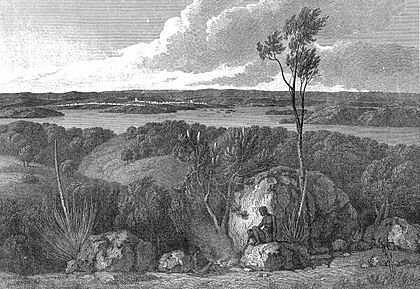
Flinders' map Y46/1, made in 1804, was not "lost." It had been stored by the UK Hydrographic Office before 1828. Historian Geoffrey C. Ingleton mentioned it in his book. By 1987, libraries in Australia had copies of it. In 2001–2002, the Mitchell Library in Sydney displayed it. In 2004, copies of the map were officially presented to the people of Australia. This event marked the first formal recognition of the naming of Australia.
Flinders was not the very first person to use the word Australia, but he was the first to apply it specifically to the continent. He owned a book by Alexander Dalrymple from 1771 and likely got the idea from there. In 1804, he wrote to his brother, "I call the whole island Australia, or Terra Australis." Later that year, he wrote to Sir Joseph Banks about "my general chart of Australia." This map was created from all the information he gathered in Australian waters and finished while he was held in Mauritius.
Flinders explained to Banks why he chose the name:
The name Australia or Terra Australis, which I have used for what has been called New Holland, should be approved by the Admiralty and map experts. It seems wrong that Captain Cook's New South Wales should be swallowed up by the Dutch name New Holland. So, I have gone back to the original name Terra Australis, or the Great South Land. This name was used by the Dutch in the 17th century. New South Wales should stay separate from New Holland. But since the whole land needs one general name, and we now know it's all one land, I think Australia is the best name for everyone.
Flinders kept promoting the name Australia until he returned to London in 1810. There, he found that Banks did not approve of the name, and New Holland and Terra Australis were still commonly used. Because of this, Flinders' book was published as A Voyage to Terra Australis, and his 1814 map also showed Terra Australis as the main name, despite his wishes. The final proofs were brought to him on his deathbed, but he was unconscious. The book was published on 18 July 1814, and Flinders passed away the next day, never knowing that his chosen name for the continent would eventually be accepted.
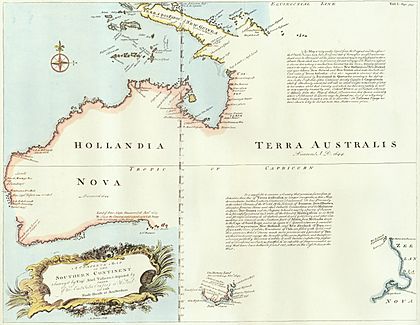
In his book, Flinders wrote:
It is unlikely that any other large landmass will be found further south. So, the name Terra Australis will describe the importance of this country and its place on the globe. It is an old name, and since it doesn't favor either of the two nations claiming it, it seems better than any other choice.
He added a note saying:
If I had changed the original term, I would have made it Australia; as it sounds better and is similar to the names of other large parts of the earth.
Flinders believed that the mythical southern continent, Terra Australis, did not exist (it was later discovered as Antarctica). Therefore, he wanted the name applied to the continent of Australia, and it eventually stuck.
Flinders' book was widely read, making the term Australia popular. Lachlan Macquarie, Governor of New South Wales, knew Flinders preferred the name Australia and used it in his messages to England. On 12 December 1817, he officially recommended it to the Colonial Office. In 1824, the British Admiralty agreed that the continent should officially be called Australia.
Flinders' Legacy
Statues and Memorials
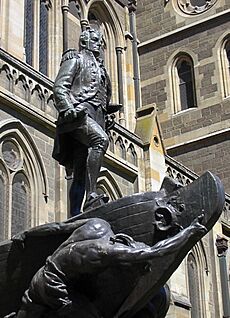
In Australia, you can find statues of Flinders in several places:
- on Macquarie Street, Sydney;
- outside St Paul's Cathedral, Melbourne;
- in the seaside town of Mornington, Victoria;
- on North Terrace, Adelaide; and
- on Tasman Terrace, Port Lincoln.
In his home country of England, the first statue of Flinders was put up on 16 March 2006 (his birthday) in his hometown of Donington. This statue also shows his cat, Trim, who traveled with him. In July 2014, on the 200-year anniversary of his death, a large bronze statue of Flinders was unveiled at Australia House, London. It was later placed at Euston station, near where his grave was thought to be.
Flinders' explorations of the Hervey Bay area are remembered with a monument called Matthew Flinders Lookout. It is at the top of a cliff facing the bay in Dayman Park, Urangan.
The Captain Flinders Memorial is a stone monument near Macondé, Mauritius, by the ocean. It is close to where he landed on 17 December 1803. The memorial has a brass plaque with details about Flinders as an explorer, navigator, and mapmaker.
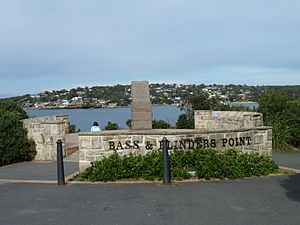
Bass and Flinders Point in Cronulla, New South Wales, has a monument to George Bass and Matthew Flinders, who explored the Port Hacking estuary.
Places Named After Flinders
Flinders never named any place after himself during his discoveries. However, his name is now linked to over 100 geographical features and places in Australia. This includes Flinders Island in Bass Strait, but not Flinders Island in South Australia, which he named for his younger brother, Samuel Flinders.
Flinders is especially important in South Australia, where he is seen as the main explorer of the state. Landmarks named after him include the Flinders Ranges and Flinders Ranges National Park; Flinders Column at Mount Lofty; Flinders Chase National Park on Kangaroo Island; Flinders Parade in Victor Harbor; Flinders University; Flinders Medical Centre; the suburb Flinders Park; and Flinders Street in Adelaide.
In Victoria, places named after him include Flinders Peak; Flinders Street in Melbourne (where Flinders Street railway station is); the suburb of Flinders; the federal electorate of Flinders; and the Matthew Flinders Girls Secondary College in Geelong.
Flinders Bay in Western Australia and Flinders Way in Canberra also honor him.
Schools named after him include Flinders Park Primary School in South Australia and Matthew Flinders Anglican College on the Sunshine Coast in Queensland. There are also Flinders Highways in both Queensland and South Australia.
In the Arts
Flinders' life has been told in radio plays like They Sailed on Friday, The Mapmaker, and My Love Must Wait. The last one was adapted from a novel by Ernestine Hill.
Other Recognition
Flindersia is a group of fourteen tree species in the citrus family. It was named by the Investigator's botanist, Robert Brown, in honor of Flinders. The eastern school whiting, Sillago flindersi, is also named after him.
A picture of Flinders was on the front of the Australian ten-shilling note from 1961–1965.
He was honored on postage stamps issued by Postmaster-General's Department in 1964, 1980, and again in 1998 with George Bass.
On 30 June 2019, the Royal Australian Navy ordered the construction of HMAS Flinders, a Hunter-class frigate to be built in Osborne.
Flinders landed on Coochiemudlo Island on 19 July 1799. The island's residents celebrate Flinders Day annually, usually on a weekend close to 19 July.
Euston's newest pub, very close to where his remains were found, has been named The Captain Flinders.
Language and People
Flinders suggested using iron bars to correct compass errors caused by iron on a ship. These are now known as Flinders bars.
Flinders also created the term dodge tide. He noticed that the tides in the shallow Spencer and St Vincent's Gulfs seemed to stop moving for several days in certain spots. Similar events have since been found in the Gulf of Mexico and the Irish Sea.
Flinders was a cousin by marriage to Sir John Franklin. Flinders inspired Franklin's love for navigation and took him on his voyage aboard Investigator.
Works
- A Voyage to Terra Australis, with an accompanying Atlas. 2 vol. – London : G & W Nicol, 18 July 1814
- Australia Circumnavigated: The Journal of HMS Investigator, 1801–1803. Edited by Kenneth Morgan, 2 vols, The Hakluyt Society, London, 2015.[1]
- Trim: Being the True Story of a Brave Seafaring Cat.
- Private Journal 1803–1814. Edited with an introduction by Anthony J. Brown and Gillian Dooley. Friends of the State Library of South Australia, 2005.
Interesting Facts About Matthew Flinders
- Flinders decided to become a navigator after reading the adventure book Robinson Crusoe.
- His first visit to the Australian continent was in February 1792. He arrived at Adventure Bay as part of William Bligh's expedition.
- Flinders was not the very first person to use the word "Australia," but he was the first to use it specifically for the continent.
- More than 100 places and features in Australia are named after him.
- In his hometown of Donington, England, a statue of Flinders was put up in 2006. It also shows his beloved cat, Trim, who sailed with him.
- Flinders noticed that tides in some shallow gulfs seemed to stop for several days. He called this a "dodge tide."
- He also suggested using iron bars to help ships' compasses work better. These are now known as Flinders bars.
See also
 In Spanish: Matthew Flinders para niños
In Spanish: Matthew Flinders para niños
- Flinders bar
- List of explorers
- Trim (cat)


